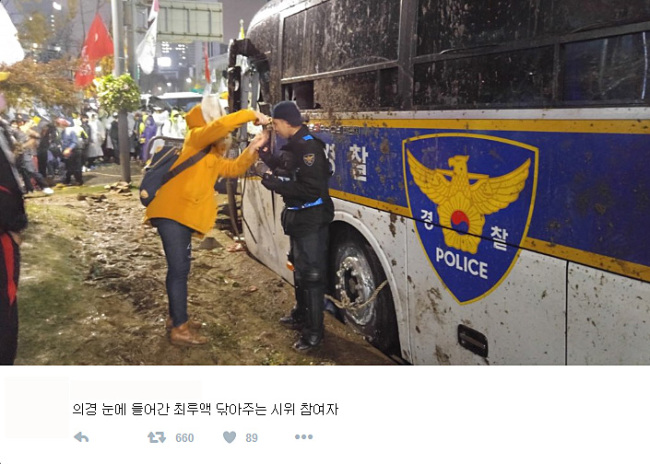On a chilly Saturday night, downtown Seoul turned into a battlefield between antigovernment protestors and the police in the largest rally held in seven years.
At the forefront of the battle were 20-something police conscripts armed with shields and helmets. Looking frightened, they confronted protestors of similar age who took to the streets against the government’s push to reintroduce state-authored history textbooks.
“I was too afraid to be there. ... I was pushed for one hour by angry protestors while trying to block them. Water mixed with tear gas dropped on my head. ... I just wanted to get away from the scene,” a conscript who was at the scene said on the condition of anonymity. “They could be my friends, you know?”
At the forefront of the battle were 20-something police conscripts armed with shields and helmets. Looking frightened, they confronted protestors of similar age who took to the streets against the government’s push to reintroduce state-authored history textbooks.
“I was too afraid to be there. ... I was pushed for one hour by angry protestors while trying to block them. Water mixed with tear gas dropped on my head. ... I just wanted to get away from the scene,” a conscript who was at the scene said on the condition of anonymity. “They could be my friends, you know?”

He is one of the young conscripts who chose to serve their 21-month mandatory national service in the police rather than in the military. The conscripts recruited by the National Police Agency are mostly dispatched to help maintain public order at protest sites across the nation.
In the rallies held at various locations in Seoul from Saturday afternoon, some 70,000 demonstrators, led by labor, civic, student and farmers’ groups, gathered to protest the government’s plan to adopt state-issued history textbooks, reform labor regulations and open up the agricultural market.
The demonstrations turned violent as the protestors tried to pull down the police bus barricades in order to march through Gwanghwamun Square to the presidential office. The police, which earlier refused to allow the march citing traffic disruptions, used water cannons to spray water mixed with tear gas to break up the crowd.
Enraged by the police crackdown, some protestors swore at the police officers, urging them to open the road toward Gwanghwamnun Square.
“You bastards! Open the way! Don’t you have a mother or father? Stop firing the water cannon.”
As the violence reached its peak at 9:30 p.m., the angry crowd attempted to bring down the police bus barricades by tying ropes to the vehicles and hitting police officers on the top of the buses with poles.
Tainting most demonstrators’ wish to hold peaceful assemblies, some radical protestors went as far as attempting to set fire to a police bus, physically abusing police officers and arousing anger in the crowd.
Such actions were largely frowned upon or ignored by fellow demonstrators, many of whom appeared to sympathize with the mostly young conscripts stuck in the middle of official demands for public order and the protesters’ determination to march forward.
Some of the demonstrators shouted, “Police officers, please come down (from the top of the buses)! It is too dangerous up there.”
A 35-year-old office worker, who participated in the rally, also told The Korea Herald that the police officers were not to blame. The government should take the blame.
“I feel so sorry for them. They are just following the orders. They are suffering from what adults have done wrong. I feel like they are putting the young at the forefront of the adults’ ideological war,” he said. “The youth are being sacrificed in vain.”
An American national, who only wanted to be identified as Patrick, said that he saw a lot of fright in all their eyes while observing the protest scene for hours. “Some of them seemed to hate what they were doing. Many might have friends out there I imagine. The looks on their faces said it all.”
The Korea Herald also witnessed a woman weeping at the corner of a police bus parked near Gwanghwamun Square. The windows of the bus were smashed, though conscripts were still inside on standby in case of emergencies.
The woman talked into the bus windows covered by shields, “My son is also a conscript. … Please don’t hurt our children. … Please, stop this violence.”
Two days after the violent protest in central Seoul ended, a photo from the scene went viral showing a protestor washing tear gas from a conscript’s eyes.
After seeing the picture, which was quickly spread on social media, a netizen said in a tweet, “Why do we have to fight like this?”
By Ock Hyun-ju (laeticia.ock@heraldcorp.com)
-
Articles by Ock Hyun-ju



















